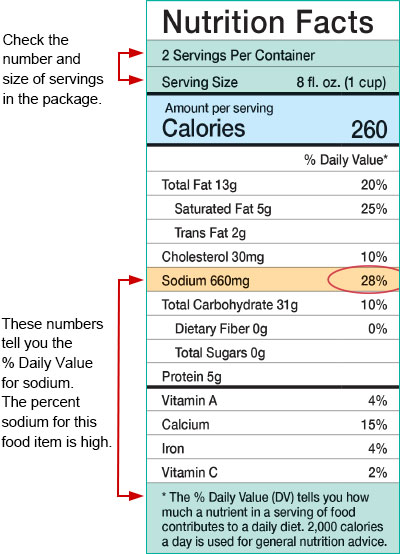Sodium and Your Health
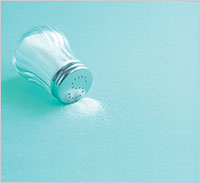
Sodium and Your Health
Sodium is a mineral that our body needs in small amounts to keep our fluids balanced. Typically, we get it in the form of salt. Most people get more sodium than their bodies need. If you have kidney disease, high blood pressure, or heart disease, ask your health care provider what the right amount of sodium is for you.
Share
Where is sodium in food?
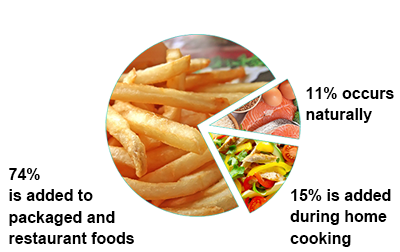
Reducing sodium can help lower your blood pressure and reduce your risk for heart disease, stroke, and kidney disease.
What about salt substitutes?
Potassium chloride is a common salt substitute. Talk with your provider before using a salt substitute. People with kidney disease are at risk for having potassium levels either too high or too low.
Ways to Reduce Sodium

- Look for foods labeled “No Added Salt,” “Low Sodium,” “Reduced Sodium,” and/or “Lightly Salted.”
- Eat more fruits and vegetables.
- Prepare meals with low sodium ingredients.
- Rinse canned vegetables, meat/fish, and beans to remove some of the sodium.
- Prepare traditional foods with less or no salt.
- Eat a smaller portion of a high sodium food or have it less often.
- Use herbs, spices, and sodium-free seasonings in place of salt.
- Look for hidden sources of sodium in sports and energy drinks, vegetable juice, and cottage cheese.
Sodium impacts people with kidney disease
Kidney disease is when your kidneys are damaged and have difficulty removing sodium from the body. This may raise blood pressure and cause water retention. Talk with your provider about the right blood pressure goal for you.
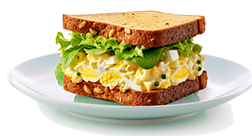
A deli or bologna sandwich can be high in sodium. Choose a low sodium food like egg salad, or peanut butter and jelly
Ideas for Reducing Foods High in Sodium
Makes changes slowly and your taste will adjust to having less salt.

Swap This
Packaged and Restaurant Food
Cured meat
- Sausage and bacon
- Ham, hot dogs, and deli meat
Soups
- Canned or instant noodles
- Broth or boullion
Instant Meals
- Flavored rice and noodles
- Pancage or muffin mixes
- Canned stews
- Frozen meals like pot pies
Snacks
- Chips, pretzels, and crackers
- Salted nuts and seeds
Fast food and restaurant meals
- Pizza, burgers, and fries
- Pastas, tacos, and more
For That
Fresh and Low Sodium Food
Fresh meat
- Bison, elk, deer, moose, and caribou
- Lean beef, poultry, or seafood
Soups from scratch
- Made with low sodium ingredients
- Homemade broth
Grains
- Rice and pasta
- Hot cereal without salt
Snacks
- Home popped popcorn
- Unsalted nuts and seeds
Other homepage meal ideas
- Wraps or sandwiches made with leftover meat or eggs
- Omelet with veggies and herbs
- Chili and stews

Read the Nutrition Facts label.
Compare and choose foods with the lowest Percent Daily Value for sodium: 5% is low and 20% is high.*
What is the daily sodium limit?
The recommended daily limit for most adults is 2,300 mg of sodium, which is about 1 teaspoon of salt from all foods and drinks. On average, people in the U.S. get 3400 mg per day, or 50% higher than the adult limit.
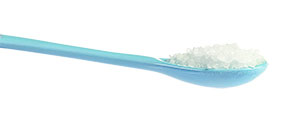
Try the DASH Eating Plan,
proven to help lower blood pressure. Learn more at,
DASH – Dietary Approach to Stop Hypertension
Looking for healthy recipes low in sodium?
See My Plate.gov
